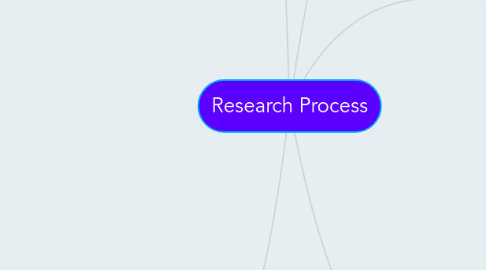
1. Step 4: Analyze found materials
1.1. Evaluate Sources(CRAAP)
1.1.1. Currency - timeliness of the information
1.1.1.1. Information Cycle
1.1.1.1.1. same day
1.1.1.1.2. week of
1.1.1.1.3. week(s) after
1.1.1.1.4. 6 months+
1.1.1.1.5. 1 year +
1.1.1.2. revised/updated?
1.1.2. Relevance - importance of the information
1.1.2.1. relate to topic/answer question?
1.1.2.2. audience
1.1.2.3. appropriate education level
1.1.3. Authority - source of the information
1.1.3.1. author/publisher/source/sponser?
1.1.3.1.1. credentials
1.1.3.1.2. organizational affiliations
1.1.3.1.3. qualifications
1.1.3.2. contact information
1.1.3.2.1. publisher
1.1.3.2.2. email
1.1.3.3. URL source
1.1.3.3.1. .edu
1.1.3.3.2. .gov
1.1.3.3.3. .org
1.1.3.3.4. .net
1.1.3.4. Source of the information
1.1.4. Accuracy - reliability, truthfulness and correctness of the content
1.1.4.1. source accuracy
1.1.4.2. information supported by evidence
1.1.4.3. reviewed or refereed
1.1.4.4. verifiable
1.1.4.4.1. personal knowledge
1.1.4.4.2. another source
1.1.4.5. unbias/free of emotion
1.1.4.6. .com
1.1.4.7. spelling, grammar, typographical errors
1.1.5. Purpose - reason for information's existance
1.1.5.1. purpose
1.1.5.1.1. inform
1.1.5.1.2. teach
1.1.5.1.3. sell
1.1.5.1.4. entertain
1.1.5.1.5. persuade
1.1.5.2. clear intension/purpose
1.1.5.3. legitimacy
1.1.5.3.1. fact
1.1.5.3.2. opinion
1.1.5.3.3. propoganda
1.1.5.4. objective/impartial point of view
1.1.5.5. identify biases
1.1.5.5.1. political
1.1.5.5.2. ideological
1.1.5.5.3. cultural
1.1.5.5.4. religious
1.1.5.5.5. institutional
1.1.5.5.6. personal
1.2. Primary vs Secondary Source
1.2.1. Primary Source
1.2.1.1. original, first hand
1.2.1.2. factual
1.2.1.3. reports, results
1.2.1.4. examples
1.2.1.4.1. diaries, journals, letters
1.2.1.4.2. newspaper and magazine articles
1.2.1.4.3. government records
1.2.1.4.4. photographs
1.2.1.4.5. paintings, drawings, sculptures
1.2.1.4.6. published results of research studies
1.2.1.4.7. published results of scientific experiments
1.2.2. Secondary Source
1.2.2.1. analyzes and interprets primary source reports, results
1.2.2.2. second-hand accounts
1.2.2.3. interpretations
1.2.2.4. examples
1.2.2.4.1. biographies
1.2.2.4.2. histories
1.2.2.4.3. book, art, theater reviews
1.2.2.4.4. analysis of a clinic trial
1.2.2.4.5. view of the results of experiments, trials
2. Step 5: Apply research materials to paper
2.1. fill into outline
2.1.1. identify useful/relevant info
2.1.1.1. summary
2.1.1.1.1. condense
2.1.1.1.2. key points
2.1.1.2. paraphrase
2.1.1.2.1. in your own words
2.1.1.2.2. different sentence structure
2.1.1.2.3. avoid "plagiaphrasing"
2.1.1.3. quote
2.2. build/expand/develop body of paper
2.3. cite your sources
2.3.1. citation page
2.3.2. in-text citations
3. Step 1: Identify Topic
3.1. evaluate options
3.2. identify requirements/goals
3.2.1. length
3.2.2. style
3.2.3. audience
3.2.4. sources
3.2.4.1. how many
3.2.4.2. appropriate types
3.3. brainstorm
3.3.1. lists
3.3.2. flow charts
4. Step 2: Outline
4.1. Lay out the paper
4.1.1. background
4.1.2. body
4.1.3. conclusion
4.1.4. citation page
4.2. Identify main points
4.2.1. sort/categorize to create Subject Headings
4.2.2. list associated/relevant key words
5. Step 3: Locate Materials(Sources)
5.1. Mediums
5.1.1. Books
5.1.2. Internet
5.1.2.1. Research Databases
5.1.2.2. Peer-Reviewed Articles
5.1.2.3. Google Scholar
5.1.2.4. Scholarly Journals
5.1.3. Magazines
5.1.4. Library Catalog
5.1.5. News Sources
5.1.5.1. digital
5.1.5.2. print
5.1.6. Social Media
5.1.7. Scholarly Articles
5.1.7.1. digital
5.1.7.2. print
5.2. Use key words from outline to search
5.2.1. search methods
5.2.1.1. boolean operators
5.2.1.2. phrase searches
5.2.1.3. truncation
5.2.2. combine search methods
